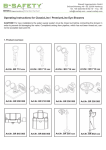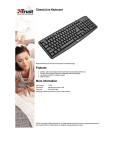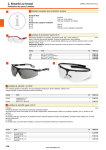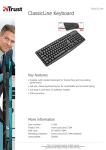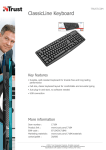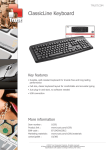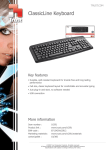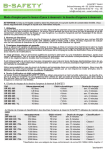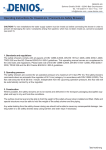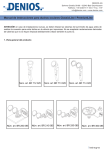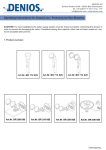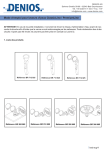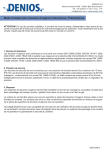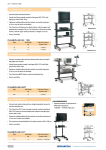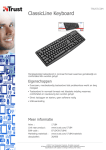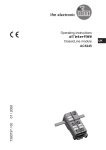Download Operating Instructions for ClassicLine / PremiumLine
Transcript
Breuell Ingenieurbüro GmbH Grützmühlenweg 40, 22339 Hamburg, Germany Phone +49 (0)40-53 80 92-10, Fax. –86 [email protected] - www.b-safety.com Operating Instructions for ClassicLine / PremiumLine Lab Safety Showers CAUTION! For new installations the water supply system must be rinsed out before connecting the shower in order to prevent dirt damaging the valve. Complaints arising from pipeline, which has not been rinsed out, cannot be accepted (see point 5). 1. Description / Scope of use Safety showers for emergency situations in which people are on fire or contaminated. NOT suitable for use in areas prone to frost. 2. Standards and regulations The B-SAFETY lab safety showers comply with all aspects of DIN 12899-3:2009, DIN EN 151541:2006, ANSI Z358.1-2004, TRGS 526 and the BG Chemie BGI/GUV-I 850-0 guidelines. This operating manual serves as a supplement to the valid rules and regulations. Please take note of the DIN 12899-3:2009, DIN EN 15154-1:2006, ANSI Z358.1-2004, TRGS 526 and the BG Chemie BGI/GUV-I 850-0 guidelines. 3. Operating pressure The B-SAFETY lab safety showers are designed for an operating pressure of a maximum of 10 bar (PN 10). The flow rate is dependent on the available water pressure as well as the cross section of the connecting pipes. At 1 bar, B-SAFETY lab safety showers have an average volume flow of 60 litres per minute. The flow rate can be limited to the required amount using the B-SAFETY flow limits available separately. 4. Installation Where possible, the safety showers are to be stored and delivered in the transport packaging (box/pallet) supplied and kept in dry and frost-free conditions. The surface must be level and be able to hold the weight of the safety shower when installed and filled. Walls and special structures must be able to hold the weight of the safety shower and the piping. Any water leaking from the safety shower during use should not be able to cause any consequential damage. Leaking water is to be safely drained away using barriers and drain trays if necessary. 4.1 Water connection The connections for the various safety showers have a ¾ or 1 ¼ inch thread. We recommend attaching the safety shower to at least a ¾ inch pipe. The water pressure should be between 2-8 bar. The water supply for the safety shower should be situated near the system and have a stop valve for maintenance and repair work that no one can tamper with. 4.2 Necessary space / installation height There must be a free space with a radius of 40 cm underneath the body safety shower. The installation height of the underside of the shower head (body safety shower) must be 210–230 cm, in accordance with DIN EN 15154-1:2006. Breuell Ingenieurbüro GmbH Grützmühlenweg 40, 22339 Hamburg, Germany Phone +49 (0)40-53 80 92-10, Fax. –86 [email protected] - www.b-safety.com 4.3 Installing wall/ceiling mounted versions Wall or ceiling mounted versions must be securely fastened to the wall/ceiling or other special structure. The technique required to fasten the shower depends on the construction and is to be decided by the installation company. 4.4 Installing over-door versions The over-door versions BR 084 075, BR 084 085 and BR 084 095 are delivered with an already attached valve adapter (type A) for installation of the rod-operated valve to the right of the door. Should installation to the left of the door be required, then the attached valve adapter (type A) must be replaced by another valve adapter (type B) which is also included in the delivery. The specialist tool (C31), which is also included in the delivery, must be used to attach the valve adapter to the ball cock. The nut of the ball cock must be tightened with a standard screw locking device. 4.5 Installing free-standing body safety showers Free-standing body safety showers must be securely fastened to the surface using the base plate. The technique required to fasten the shower depends on the construction and is to be decided by the installation company. 4.6 Models with eye showers 4.6.1 Models with ClassicLine safety eye showers Combine the eye shower and body safety shower using the adapter provided. 4.6.2 Models with ClassicLine / PremiumLine hand-held eye showers Screw the bracket for the hand-held eye shower on at a height of approximately 900 mm. Connect the hand-held eye shower to the body safety shower with the hose using the double adapter. 4.6.3 Models with PremiumLine eye/face wash units Remove the base of the eye shower. Drill the holes for the pipe clamps using the template provided. Place the eye shower at a height of 970 mm on the body safety shower and fasten it using the pipe clamps, screws and nuts. Install the base. Connect the eye shower to the body safety shower with the hose using the double adapter. 5. Water supply The B-SAFETY body safety showers must be connected to drinking water. The drinking water network must be set up in accordance with DIN 1988 and DIN EN 1717. CAUTION! For new installations the water supply system must be rinsed out before connecting the shower in order to prevent dirt damaging the valve. The high-performance shower head must be deinstalled during this process. It must be reinstalled after the rinsing process. The high-performance shower head can be fastened and tightened using a pin type face wrench (item no. BR 010 100). 6. Safety labelling The enclosed safety label (self-adhesive label) is to be attached near the B-SAFETY body safety shower. Breuell Ingenieurbüro GmbH Grützmühlenweg 40, 22339 Hamburg, Germany Phone +49 (0)40-53 80 92-10, Fax. –86 [email protected] - www.b-safety.com 7. Location The location is to be chosen in accordance with the BG Chemie BGI/GUV-I 850-0 guidelines. Access must always be kept clear. Special care must also be taken at the installation location that the safety shower: • • • • cannot be damaged by vehicles. is readily accessible to users at all times. is less than 10 metres away from the potential danger zone and can be reached within 10 seconds. For highly corrosive substances, a distance between 3-6 metres is recommended. The area around the shower must be well-lit and the shower itself must be clearly identified by easily visible signs. 8. Operating 8.1 Body safety showers with pull rods Pull the handle until the valve arm stops. Once showering begins, remove all contaminated items of clothing that are not stuck to the skin and rinse all affected areas with clean and cold water. Push the lever upwards until the valve closes to turn off the shower. Contact a doctor! 8.2 Body safety showers operated using a rocker arm Pull the rocker arm forward until it stops. Once showering begins, remove all contaminated items of clothing that are not stuck to the skin and rinse all affected areas with clean and cold water. Push the lever back towards the wall until the valve closes to turn off the shower. Contact a doctor! 8.3 Body safety showers operated using a pivot lever Turn the pivot lever in the direction instructed. Once showering begins, remove all contaminated items of clothing that are not stuck to the skin and rinse all affected areas with clean and cold water. Push the lever in the opposite direction until the valve closes to turn off the shower. Contact a doctor! Breuell Ingenieurbüro GmbH Grützmühlenweg 40, 22339 Hamburg, Germany Phone +49 (0)40-53 80 92-10, Fax. –86 [email protected] - www.b-safety.com 9. Maintenance / Problems The safety shower must be checked for visible damage or faults after installation and before being put into use and subsequently at the intervals stated and after any alterations or maintenance. 9.1 Maintenance The B-SAFETY lab safety showers must be checked for operation at least once a month. This is also set out in the BGI/GUV-I 850-0 guidelines from BG Chemie. For this purpose, the shower must be turned on for approximately 5 seconds. This not only checks the operation of the shower itself but also replaces the water in the shower with fresh water (contamination protection). During the course of this test, the shower is to also be inspected visually to see how it closes and if any leaks or dirt, such as dust or limescale, are apparent. Faulty parts must be replaced immediately. 9.2 Problems Problem Possible cause Possible solution The amount of water coming out Water pressure or cross section of the shower does not appear to of the connecting pipes is too be sufficient. low. Check the piping. Ensure that the piping has a minimum diameter of ¾ inches and that the water pressure is at least 2 bar. The shower drips continuously. The valve does not close properly. Check the valve for damage and ensure that the valve is pushed back into a fully-closed position. The shower drips continuously. The valve seal is damaged. Replace the valve. The body safety shower does This is NOT a fault. This is a not automatically switch itself off requirement according to DIN after use. standards. This is NOT a fault. This is a requirement according to DIN standards. 10. Disposal The safety shower can be fully dismantled. The individual parts, e.g. metal, insulation etc, can be recycled separately. Please note the national and international disposal regulations. Operating Instructions ClassicLine/PremiumLine Lab Safety Showers B-SAFETY – Status 06-2010




